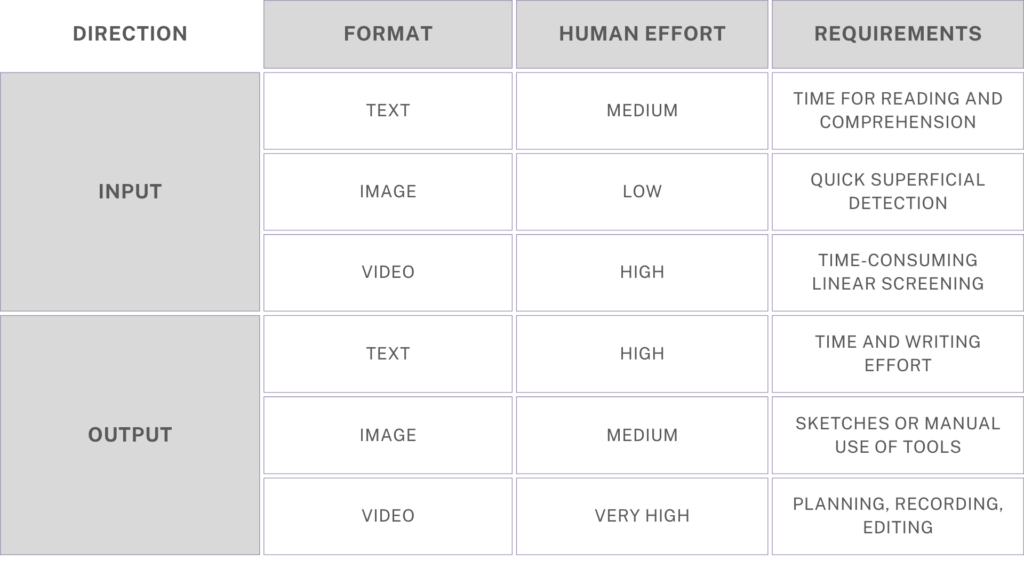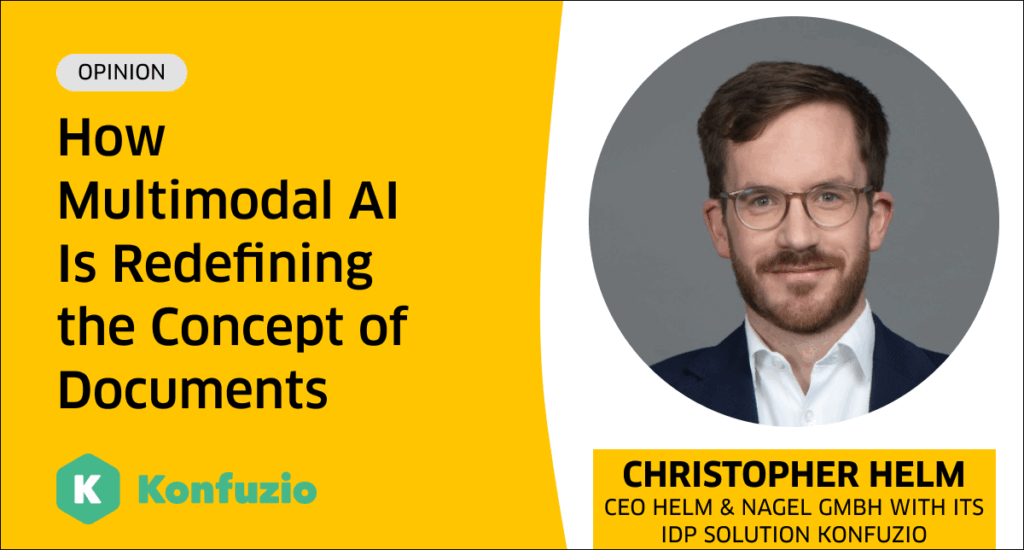Curious about what keeps experts, CEOs and other decision-makers in the Intelligent Document Processing (IDP) space on their toes? Get food for thought on IDP-related topics from the industry’s leading minds.
In this opinion piece, Christopher Helm, CEO of Helm & Nagel GmbH with its Intelligent Document Processing (IDP) solution Konfuzio, explores the topic of ‘fluid documents’ – “a paradigm where documents are no longer static files but dynamic entities” – and how they are changing business processes.
In our previous opinion piece, we introduced the concept of the fluid document – a transformative paradigm enabled by multimodal AI, where documents are no longer static files but dynamic entities capable of reconfiguring themselves based on context, modality, and user intent. The multimodality capability of language models, i.e. the flexible processing and generation of audiovisual content, is already replacing traditional input management by flexible oscillation between input and output.
This redefinition is not just philosophical – it’s profoundly practical. We are already witnessing entire industry processes reshaping themselves around this new form of intelligence. The central promise of fluid documents lies in their ability to dissolve format boundaries – seamlessly integrating text, images, audio, and data streams – and morphing in real time to fit the needs of users. But how do we measure the relevance or impact of this transformation on real-world business processes?

When Fluidity Meets Function: Criteria for Transformation
Not every process benefits equally from document fluidity. However, several characteristics indicate strong potential for transformation:
- Heterogeneous Formats
Processes involving diverse inputs – text, images, audio, PDFs – pose challenges for conventional systems. Fluid documents thrive by merging formats into a unified, coherent structure. - Manual Repetition
Workflows requiring frequent human input for tasks like extraction or classification are ideal for automation. Fluid documents reduce this need through contextual understanding and dynamic structuring. - High Information Density
Dense, complex content often overwhelms static systems. The fluid model selectively condenses and presents information based on user needs and role. - Decision-Making Relevance
When processes influence operational or strategic decisions, the ability to adapt and surface the right data at the right moment delivers clear value. - Collaborative Dependency
In multi-stakeholder workflows, fluid documents enhance clarity and coordination by adapting views and interactions to each participant.
When these criteria converge, the potential for transformation becomes not only likely but inevitable. Let’s explore three industries where fluid documents are already starting to reshape processes from the inside out.
Real-World Fluidity: Three Industry Use Cases
Across industries, fluid documents are catalyzing a quiet transformation. The following cases illustrate how multimodal, context-aware document processing is redefining core operational flows.
Insurance: Claims Reporting & Processing
In the insurance sector, the claims process begins with highly fragmented input from policyholders and third parties: handwritten damage descriptions submitted via app or email, photographic evidence from smartphones, voice memos left with customer service, and scanned police or repair reports from external sources. Traditionally, these inputs are siloed and manually interpreted by claims adjusters. With fluid documents, however, the claim becomes a dynamically composed, context-aware entity. Multimodal inputs are unified and semantically mapped into an evolving case file that adapts depending on who accesses it.
For example, customer service teams may see a visual summary of damages with key timeline entries, while legal departments receive structured textual evidence relevant to liability assessment. Damage photos are analyzed using AI to support preliminary classification (e.g., type of damage, severity), while voice recordings are transcribed, summarized, and linked to incident context. This fluid representation enables faster triage of claims by highlighting missing information proactively, accelerates settlement through structured, machine-readable summaries, and supports better communication across departments. For end users, the benefit is visible: fewer back-and-forths due to missing documents, quicker transparency on next steps, and a clearer understanding of expected timelines – which also helps to ensure that the process remains auditable and compliant.
Finance: Credit Analysis & Lending
In credit origination, analysts also handle a wide mix of inputs: digital application forms, income proofs (e.g., pay slips, tax returns), ID scans, bank statements, and correspondence with the applicant. These documents arrive in various formats – PDFs, scanned images, structured XML exports, or even free-text emails – often requiring time-consuming manual review and data entry. A fluid document unifies these materials into an adaptive, role-based credit dossier. Risk officers receive ratio-driven dashboards, compliance sees regulation-relevant excerpts, while front-office staff get status summaries for communication.
Structured data is extracted automatically, ID documents are verified, and financial indicators are visualized or flagged based on risk thresholds. The process is improved by reduced handovers, minimized input errors, and enables more confident lending decisions without adding friction for applicants. To maintain transparency and explainability, AI-generated summaries or classifications must always refer to the original claim documents, photographic evidence or transcripts to ensure traceability. Liability assessments and payout decisions remain in human hands, with the system supporting, but not replacing, expert review.
Healthcare: Patient Intake & Medical History Processing
The intake process in healthcare is particularly characterized by a wide range of unstructured documents: scanned referral letters, handwritten intake forms, lab results, radiology reports, consent forms, and even patient-generated data from health apps. These arrive in various formats – PDFs, images, HL7 exports, or free-text emails – and must be quickly reviewed, sorted, and made actionable by medical staff. Fluid documents transform this complex entry point into a dynamic, context-sensitive patient file. Text-based findings are semantically extracted and tagged, medical histories are summarized according to specialty needs, and diagnostic images are linked with relevant narrative context.
A nurse may receive an overview of medications and allergies, while a physician sees structured symptom clusters and timeline-based summaries of previous diagnoses and treatments. This approach reduces redundant data entry, prevents information gaps between departments, and accelerates informed medical decision-making. Patient safety improves through more complete context, while clinical staff gain time for direct care. Sensitive health data remains traceable and explainable, ensuring compliance with privacy regulations and fostering trust in AI-augmented clinical workflows.
Dynamic Intelligence: Redefining the IDP Stack
The transformative potential of multimodal LLMs represents more than a UI or data model innovation – it marks a foundational shift in the architecture of document-based systems. In an IDP market once defined by deterministic extraction and rigid rule sets, the notion of documents as context-sensitive, role-aware, and multimodally interpreted entities demands a new technological stack. Another part of this transformation is the AI agent: not just a model interface, but a self-directed unit capable of retrieving, interpreting, and acting upon document data based on user intent.
Unlike classic IDP components, agents operate across modalities and systems, coordinating retrieval (via RAG), reasoning (via LLMs), and structured output. As documents become more interactive, agents become the logic layer that maps intent to outcome, input to response. In this new landscape, the document is no longer a final product – it is a live interface that oscillates between input and output. Every question, annotation, or decision transforms the document’s shape and relevance. The enterprise that can make this oscillation fast, cost-efficient, and trustworthy will radically enhance its internal knowledge use.

About the Author
Christopher Helm is CEO of Helm & Nagel GmbH, an international provider of artificial intelligence (AI) and new enabling technologies. Among those is the software Konfuzio, an AI-based platform for process optimization and data-based knowledge gain.
Click here to find more news from Konfuzio.
📨Get IDP industry news, distilled into 5 minutes or less, once a week. Delivered straight to your inbox ↓








